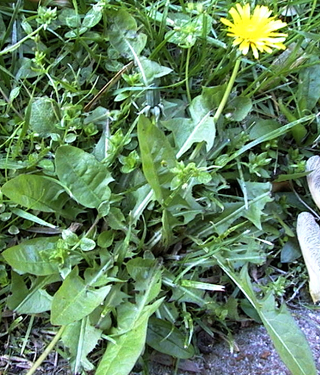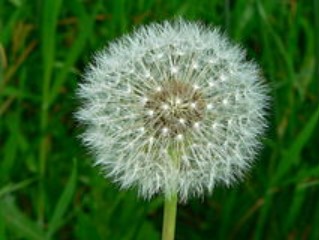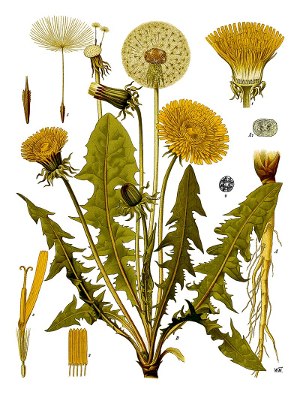Contents:
Common Names | Parts Usually Used | Plant(s) & Culture | Where Found | Medicinal Properties | Biochemical Information
Legends, Myths and Stories | Uses | Formulas or Dosages | Nutrient Content | How Sold | Warning | Resource Links | Bibliography
Scientific Names

- Taraxacum officinale L.
- Leontodon taaraxacum, Wigers
- Compositae
- Composite family
Common Names
- Blow ball
- Cankerwort
- Lion’s tooth
- Priest’s crown
- Puff ball
- Pu gong ying
- Pu-kung-ying
- Swine snout
- White endive
- Wild endive
Parts Usually Used
Roots, tops, and leaves.
Back to Top
Description of Plant(s) and Culture
Description is hardly necessary. A familiar weed;
Back to Top
Where Found

The golden-yellow flower-heads of this poor, despised plant brighten up fields, hedgerows and many a drab piece of land. Found on lawns, waste places, throughout the United States and Canada. Native of Europe, found in most of the world.
Back to Top
Medicinal Properties
Alterative, antiviral, cholagogue (increase the flow of bile), deobstruent, diuretic, stomachic, hepatic, laxative, tonic, aperient, (a very mild laxative), liver and digestive tonic.
Back to Top
Biochemical Information
Biotin, calcium, choline, fats, gluten, gum, inositol, inulin, iron, lactupicrine, linolenic acid, magnesium, niacin, PABA, phosphorus, potash, proteins, resin, sulfur, vitamins A, B1, B2, B5, B6, B9, B12, C, E, and P, and zinc.
Leaves: bitter glycosides, carotenoids, terpenoids, choline, potassium salts, iron and other minerals,
Root: bitter glycosides, tannins, triterpenes, sterols, volatile oil, choline, asparagin, inulin.
Back to Top
Legends, Myths and Stories

Potassium is often flushed from the body when synthetic diuretics are taken. But dandelion has an abundance of potassium to off-set this problem.
The feathery seed balls of the dandelion were once used by young girls to determine if their true loves were really true. They would blow on the dandelion fuzzy ball
Culpeper says dandelion is “vulgarly called
Since the 7th century, the Chinese have known about the antibacterial properties of the juice of the dandelion. Researchers recently discovered that dandelion may protect against cirrhosis of the liver. In Europe, the dandelion first appears as being used medicinally in 1485. The name dandelion was invented by a 15th century surgeon, who compared the shape of the leaves to a lion’s tooth, or dens leonis. Old timers called dandelion the “King of Weeds.”
A French authority claimed that the flowers and stems of dandelion are “enormously rich in estrogen.” Dandelion was brought to the New World by the early colonists. They used the whole plant. The flowers made wine, the leaves made salads, the stems and roots dried and used medicinally. According to stories, dandelion never grows where there are no human inhabitants. The early pioneers found no trace of them in western America. After a few years, up sprang a dandelion head and soon there were millions of them. Native Americans learned to love them and would walk miles to gather them if they could not be found locally.
Dandelion coffee is made of high quality roots, now grown on specialized farms. Proper harvesting, drying and skillful roasting methods give dandelion a remarkable roasted flavor that many people readily accept as a coffee substitute. Dandelion coffee has been found to be of benefit to dyspeptic people, who cannot tolerate real coffee. The roasted root has no caffeine, so drink it as often as desired, even as a night cap.
Roasted dandelion root has almost a magical effect upon milk. Steep
Add
Back to Top
Uses
A mildly bitter herb that cleanses the bloodstream and liver and increases the production of bile. A natural diuretic and digestive aid. Improves function of the pancreas, spleen, stomach and kidneys. Take for anemia, gall bladder problems, gout, rheumatism, jaundice, anemia, cirrhosis, typhoid fever, neuralgia, hepatitis, abscesses, boils, decayed teeth, snakebites, cramps, fluid retention, constipation, and breast tumors.
May aid in the prevention of breast cancer and age spots. Reduces serum cholesterol, and uric acid. The greatest benefit of this herb is to help detoxify any poisons in the liver, but is also has been beneficial in lowering blood pressure. Root is one of the best remedies for treatment of hepatitis and may be a possible preventative for breast cancer.
Recommended for treating arthritis; it is said to disperse acidic deposits from the affected joints. To benefit from this herb, the leaves (slightly bitter) should be eaten raw in salads; or prepare an infusion in the usual way. Also, the ‘milk’ from the hollow stalks of this plant may be applied with good effect to all pimples, canker sores, ulcers, edema, and sores.
Dried root thought to be weaker, often roasted as coffee substitute. Dried leaf tea is a folk laxative. Experimentally, root is hypoglycemic, weak antibiotic against yeast infections (Candida albican), stimulates flow of bile and weight loss. All plant parts have served as food. Leaves and flowers are rich in
In Chinese medicine, dandelion is regarded as a blood cleanser, tonic, diabetes, and digestive aid. It is ground and applied as a poultice to snake bites.
Back to Top
Formulas or Dosages
Combine dandelion root, ginseng, and ginger root taken along with a sound nutritional diet will help people suffering from low blood sugar. Take a cup of this blend of tea, using either extracts or dried herbs,
Hearty spring salads are quite effective. Gather the fresh dandelion leaves, the young stinging nettle leaves (Urtica dioica), and the birch leaves that are just unfolding. Mince the leaves and add this healthful green seasoning to any clear or thickened soup, vegetable stew, or salad shortly before serving. Sprinkle the finely chopped dandelion leaves onto a piece of buttered bread, mix them with farmer’s cheese or another soft cheese, or put them on potatoes. If eaten regularly, you will be stimulating your body metabolism.
Dandelion root tea: Pour
Fresh dandelion juice makes a good spring tonic. Flowers make dandelion wine.
Back to Top
Nutrient Content
Calcium, fats, iron, magnesium, niacin, phosphorus, proteins,
Back to Top
How Sold
Capsules: take 1 capsule 3 times per day.
Extract: mix 10 to 30 drops in juice or water daily.
Back to Top
Warning
Contact dermatitis reported from handling the plant, probably caused by the latex in the stems and leaves.
Back to Top
Resource Links
LiveStrong.com: Dandelion Root Information
LiveStrong.com: Dandelion Root Vs. Dandelion Leaf
LiveStrong.com: Milk Thistle & Dandelion on an Empty Stomach
LiveStrong.com: Dandelion & Fenugreek Interaction
LiveStrong.com: Dandelions & Cholesterol
LiveStrong.com: Benefits of Drinking Dandelion Tea
Memorial Sloan-Kettering Cancer Center: Dandelion
U.S. National Library of Medicine: Dandelion
University of Maryland Medical Center: Dandelion
National Center for Complementary & Alternative Medicine: Dandelion
PubMed.gov: Amelioration of oxidative stress by dandelion extract through … acute liver injury
PubMed.gov: The diuretic effect in human subjects of an extract of Taraxacum officinale folium
Bibliography
![]() Back to Eden
Back to Eden, by Jethro Kloss; Back to Eden Publishing Co., Loma Linda, CA 92354, Original copyright 1939, revised edition 1994
![]() Chinese Medicinal Herbs
Chinese Medicinal Herbs, compiled by Shih-Chen Li, Georgetown Press, San Francisco, California, 1973.
![]() Culpeper’s Complete Herbal & English Physician: Updated With 117 Modern Herbs
Culpeper’s Complete Herbal & English Physician: Updated With 117 Modern Herbs, by Nicholas Culpeper, Meyerbooks, publisher, PO Box 427, Glenwood, Illinois 60425, 1990, (reprint of 1814)
![]() The Herb Book
The Herb Book, by John Lust, Bantam Books, 666 Fifth Avenue, New York, NY. copyright 1974.
![]() Indian Herbalogy of North America
Indian Herbalogy of North America, by Alma R. Hutchens, Shambala Publications, Inc., Horticultural Hall, 300 Massachusetts Avenue, Boston, Massachusetts 02115, 1973
![]() Eastern/Central Medicinal Plants
Eastern/Central Medicinal Plants, by Steven Foster and James A. Duke., Houghton Mifflin Company, 215 Park Avenue South, New York, NY 10000
![]() The Nature Doctor: A Manual of Traditional and Complementary Medicine
The Nature Doctor: A Manual of Traditional and Complementary Medicine, by Dr. H.C.A. Vogel; Keats Publishing, Inc., 27 Pine Street (Box 876) New Canaan, CT. 06840-0876. Copyright Verlag A. Vogel, Teufen (AR) Switzerland 1952, 1991
Herbal Gardening, compiled by The Robison York State Herb Garden, Cornell Plantations, Matthaei Botanical Gardens of the University of Michigan, University of California Botanical Garden, Berkeley., Pantheon Books, Knopf Publishing Group, New York, 1994, first edition
![]() The Herbalist Almanac
The Herbalist Almanac, by Clarence Meyer, Meyerbooks, publisher, PO Box 427, Glenwood, Illinois 60425, copyright 1988, fifth printing, 1994
 Old Ways Rediscovered
Old Ways Rediscovered, by Clarence Meyer, Meyerbooks, publisher, PO Box 427, Glenwood, Illinois 60425, published from 1954, print 1988
 How Indians Use Wild Plants for Food, Medicine & Crafts
How Indians Use Wild Plants for Food, Medicine & Crafts, by Frances Densmore, Dover Publications, Inc., 180 Varick Street, New York, NY 10014, first printed by the United States Government Printing Office, Washington, in 1928, this Dover edition 1974
![]() The Complete Medicinal Herbal
The Complete Medicinal Herbal, by Penelope Ody, Dorling Kindersley, Inc, 232 Madison Avenue, New York, NY 10016, First American Edition, copyright 1993
 Earl Mindell’s Herb Bible
Earl Mindell’s Herb Bible, by Earl Mindell, R.Ph., Ph.D., Simon & Schuster/Fireside, Rockefeller Center 1230 Avenue of the Americas, New York, New York 10020
![]() Planetary Herbology
Planetary Herbology, by Michael Tierra, C.A., N.D., O.M.D., Lotus Press, PO Box 325, Twin Lakes. WI 53181., Copyright 1988, published 1992
![]() American Folk Medicine
American Folk Medicine, by Clarence Meyer, Meyerbooks, publisher, PO Box 427, Glenwood, Illinois 60425, 1973
![]() Prescription for Nutritional Healing, Fifth Edition: A Practical A-to-Z Reference to Drug-Free Remedies Using Vitamins, Minerals, Herbs & Food Supplements
Prescription for Nutritional Healing, Fifth Edition: A Practical A-to-Z Reference to Drug-Free Remedies Using Vitamins, Minerals, Herbs & Food Supplements, by James F. Balch, M.D. and Phyllis A. Balch, C.N.C., Avery Publishing Group, Inc., Garden City Park, NY
![]() Webster’s New World Dictionary
Webster’s New World Dictionary, Third College Edition, Victoria Neufeldt, Editor in Chief, New World Dictionaries: A Division of Simon & Schuster, Inc., 15 Columbus Circle, New York, NY 10023
 An Instant Guide to Medicinal Plants
An Instant Guide to Medicinal Plants, by Pamela Forey and Ruth Lindsay, Crescent Books (January 27, 1992).
 A Useful Guide to Herbal Health Care
A Useful Guide to Herbal Health Care, HCBL (Health Center for Better Living).,1414 Rosemary Lane, Naples, FL 34103., Special Sale Catalog, 1996
![]() The Yoga of Herbs: An Ayurvedic Guide to Herbal Medicine
The Yoga of Herbs: An Ayurvedic Guide to Herbal Medicine, by Dr. David Frawley & Dr. Vasant Lad, Lotus Press, Twin Lakes, Wisconsin, Second edition, 1988.
 The Rodale Herb Book: How to Use, Grow, and Buy Nature’s Miracle Plants (An Organic gardening and farming book)
The Rodale Herb Book: How to Use, Grow, and Buy Nature’s Miracle Plants (An Organic gardening and farming book), edited by William H. Hylton, Rodale Press, Inc. Emmaus, PA, 18049., 1974
 The Healing Plants
The Healing Plants, by Mannfried Pahlow, Barron’s Educational Series, Inc. 250 Wireless Blvd., Hauppauge, NY 11788, 1992
